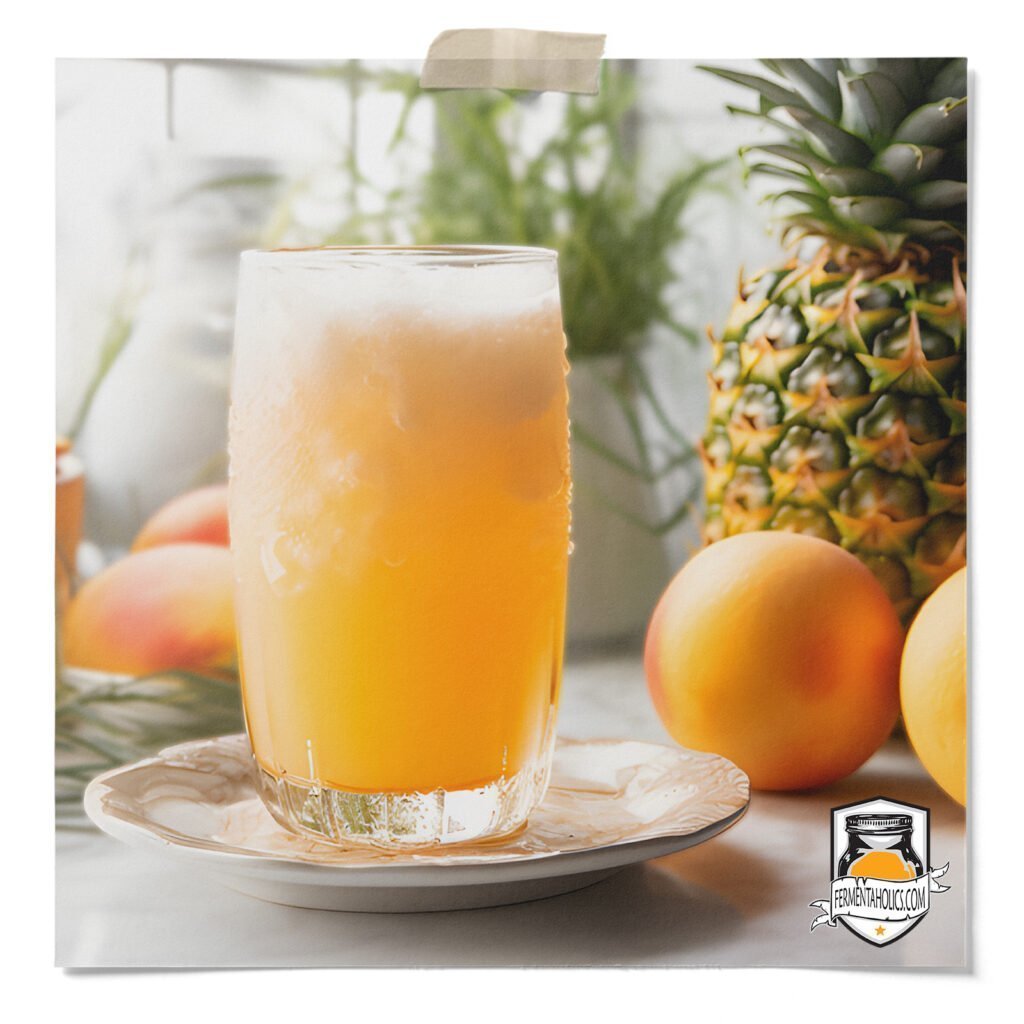
What’s not to love about pineapple and peach? Succulent and sweet, both of their flavors unite with the tartness of kombucha in a big refreshing way. Blending up the peaches creates a smooth, creamy body and gives the kombucha a smoothie like essence. Pineapple’s bold tropical flavor harmonizes with the kombucha’s acidic punch and lays a solid framework for the peach to shine in its unique sweet, juicy light.
It’s important to note that making homemade kombucha is almost always a two-step fermentation process. Brewing kombucha is only a one-step process for those who prefer an unflavored flat kombucha. Otherwise, the steps consist of a primary fermentation and a secondary fermentation.
Primary fermentation is the first step of the kombucha brewing process. This is where your SCOBY transforms regular sweet tea into the tart and slightly sweet kombucha we love. At the end of this stage, you will have finished kombucha, but it will be flat and unflavored. Have you skipped this step? Then check out our guide on how to make kombucha at home, and for jun kombucha, see our post on how to make jun kombucha tea at home. Traditional kombucha is going to yield a bolder brew, while jun kombucha is milder and can be a bit tarter.
Secondary fermentation is the step where you bottle, carbonate, and flavor your kombucha with the addition of sugar and flavors. In this step, the finished kombucha from the primary is mixed with sugar, fruits, or other flavors before bottling it with specialized lids that can hold pressure, like flip-top bottles. The bottled kombucha is then left at room temperature for natural fermentation, where yeast carbonates the kombucha within the sealed bottle. The ideal temperature range for this process is between 75-85°F. The amount of time needed to carbonate within the bottle is highly tied to temperature, which can take anywhere from 2-10 days.
💡Since this recipe is for the secondary fermentation, to make this recipe, you’ll need to have kombucha that has finished the primary fermentation and is ready to bottle.
This pineapple peach kombucha recipe makes one 16 ounce bottle. For a one-gallon batch, make 7 16 oz bottles of kombucha or times the ingredients by seven. Before beginning this recipe, you will want to:
This recipe is super simple. We’ll have you enjoying your own pineapple peach kombucha in no time. Let’s dive in:
16 Oz Bottles
20
Minutes2-10
DaysThis pineapple peach kombucha recipe is for one 16 ounce bottle. For a gallon batch, make seven bottles. To scale this recipe to a gallon batch, multiply the ingredients by seven or toggle the serving size up to seven above. Before bottling your kombucha, remove the SCOBY pellicle along with 12-16 ounces of kombucha starter tea from your brew, and reserve for your next batch.
16 Oz Kombucha from a completed primary fermentation.
1/8 Cup Chopped Pineapple
1/8 Cup Chopped Peach
1 16 Oz Airtight bottle(s)
Blender
Strainer – Optional
Place pineapple and peach pieces in a blender with about ¼ cup of kombucha and puree until smooth. Add more kombucha if needed to help the blender along.
Using a funnel, pour the pineapple peach mixture into an empty bottle.
Fill each bottle with kombucha, leaving about 1 to 2 inches of head-space. Tightly place the caps on each bottle.
Keep bottles at room temperature for 2-10 days; it will carbonate faster at higher temperatures and slower when cold.
Once per day, you’ll want to burp the bottles. This is done by removing the cap to allow built-up pressure to escape then placing the cap back on. As soon as you put the lid back on, the carbonation will begin to build back up, so no worries about it getting flat. Try not to skip this, or you may get kombucha all over your face when you do go to open it or, worse yet, a bottle bomb.
Chill in the refrigerator once you’re happy with the carbonation levels. Based on preference, you can serve as is or strain before drinking.
